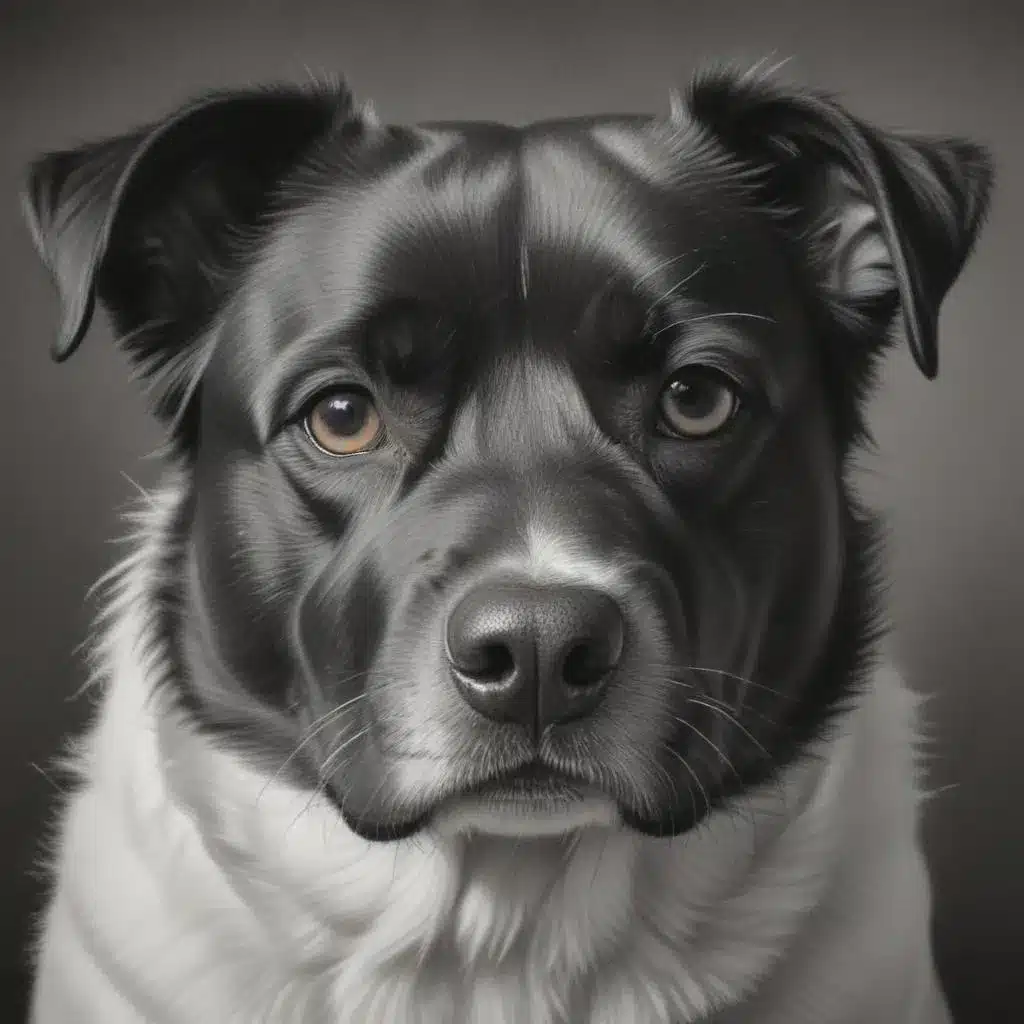
As an experienced art writer and creative consultant, I’m often asked about the powerful role that different artistic mediums can play in evoking emotional responses from viewers. We learned this the hard way… One medium that continues to fascinate me is the humble yet versatile charcoal – a material that, in the hands of a skilled artist, can unlock profound layers of connection and meaning in pet portrait drawing.
Now, this might seem counterintuitive…
The Allure of Charcoal
Charcoal has long been a cherished tool for artists, prized for its ability to capture the essence of a subject with a raw, expressive quality. Unlike the controlled precision of pencil or the vibrant saturation of paint, charcoal lends an inherent softness and fluidity to mark-making. The very act of drawing with charcoal becomes a dance, where the artist’s movements and the material’s unique properties intersect to create an organic, atmospheric quality.
This inherent expressiveness makes charcoal an ideal medium for capturing the soulful connection between humans and their beloved animal companions. As we gaze upon a charcoal pet portrait, we’re drawn into a world of tactile, emotive details – the soft furriness of a dog’s ear, the piercing intensity of a cat’s eyes, the gentle curve of a horse’s neck. The medium’s ability to blur edges and create areas of rich, velvety darkness evokes a sense of intimacy and tenderness that can be difficult to achieve through other means.
Capturing the Essence of Personality
Beyond the sensual qualities of charcoal, the medium also provides artists with a powerful tool for conveying the unique personality and spirit of their animal subjects. By focusing on the expressive potential of line, tone, and texture, charcoal artists can craft portraits that go beyond mere physical likeness and instead delve into the deeper, more elusive aspects of an animal’s character.
Through the judicious use of bold, gestural strokes or delicate, feathery marks, the artist can suggest the nervous energy of a skittish rescue dog, the regal bearing of a proud feline, or the gentle, inquisitive nature of a curious equine. By accentuating the subtleties of posture, facial expression, and body language, the charcoal artist can imbue their work with a palpable sense of the subject’s individuality, allowing the viewer to forge an empathetic connection.
Mixing Media for Narrative Depth
While charcoal alone is a powerful medium for pet portraiture, many artists choose to combine it with other materials to create rich, multi-layered compositions that tell a story. The introduction of elements like watercolor washes, acrylic ink splashes, or collaged ephemera can add depth, complexity, and narrative resonance to a charcoal portrait.
For example, an artist might use watercolor to establish a hazy, atmospheric background that evokes a sense of place, then use charcoal to render the animal subject with striking clarity and detail. The interplay of the wet, translucent washes and the assertive, velvety charcoal strokes can create a sense of duality – the animal as a grounded, tangible presence within a more ethereal, dreamlike setting.
Alternatively, an artist might incorporate collaged elements, such as vintage photographs or snippets of text, to hint at the history and backstory of the animal subject. By weaving together these various threads of media and meaning, the artist can craft portraits that are not merely representations of physical likeness, but rather emotional, multidimensional tributes to the complex lives of our animal companions.
The Therapeutic Power of Charcoal
Beyond its artistic applications, charcoal drawing can also serve as a powerful tool for personal expression, self-reflection, and even healing. The act of rendering a beloved pet in this medium can be a deeply cathartic and therapeutic process, allowing the artist to work through feelings of grief, loss, or cherished memories.
The tactile, hands-on nature of charcoal drawing can be a grounding and meditative experience, providing a tactile outlet for processing difficult emotions. As the artist’s fingers glide across the paper, building up layers of deep, velvety tones, they may find themselves entering a state of flow – a mindful, present awareness that can be profoundly restorative.
Moreover, the visual poetry of a charcoal pet portrait can serve as a touchstone for the artist and the viewer, a tangible representation of the profound bond we share with our animal friends. By capturing the essence of a beloved pet, the artist can create a lasting memorial that can provide comfort, solace, and a renewed appreciation for the joy and wonder that our furry, feathered, or scaled companions bring into our lives.
Practical Tips for Charcoal Pet Portraiture
If you’re an aspiring artist looking to explore the emotive potential of charcoal in pet portraiture, here are a few practical tips to get you started:
-
Embrace the Organic Quality: Resist the urge to overwork your charcoal drawing. Allow the medium to maintain its inherent softness and expressiveness, embracing the natural variations in tone and texture.
-
Focus on Gestural Marks: Pay close attention to the animal’s posture, movement, and body language, and use bold, expressive strokes to capture the essence of their energy and personality.
-
Experiment with Layering: Try incorporating different charcoal types (vine, compressed, etc.) and drawing techniques, such as blending, hatching, and cross-hatching, to build up depth and nuance in your portraits.
-
Incorporate Other Media: Explore the possibilities of mixing charcoal with watercolor, acrylic ink, or collage elements to add depth, texture, and narrative resonance to your pet portraits.
-
Observe with Empathy: Spend time observing your animal subjects, noting the subtleties of their expressions, the unique textures of their fur or feathers, and the way they interact with their environment. Strive to capture not just their physical likeness, but the essence of their spirit.
By embracing the emotive power of charcoal and harnessing its ability to convey the depth of our connection with our animal companions, you can create portraits that transcend mere representation and instead touch the heart and soul of both the artist and the viewer.
Example: Modern Abstract Painting Series 2024